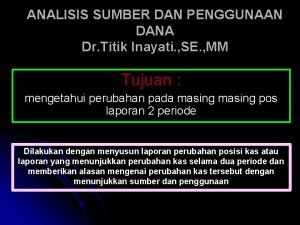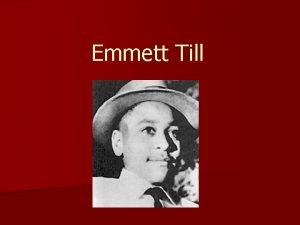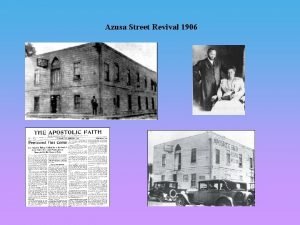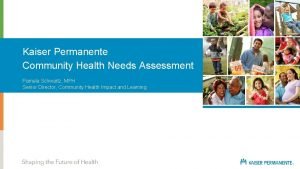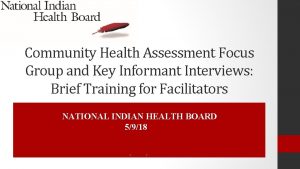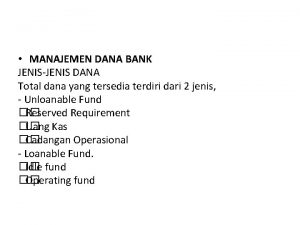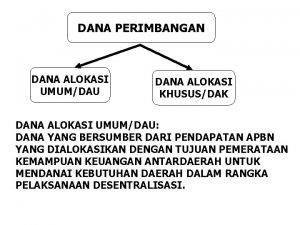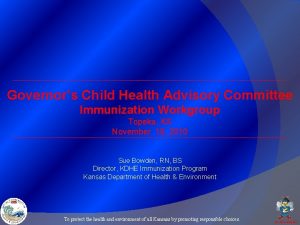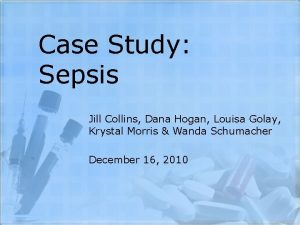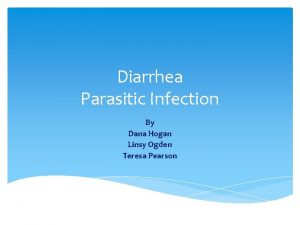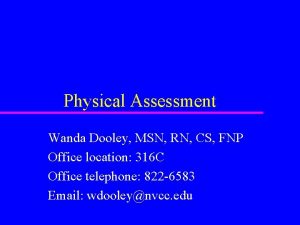Topeka Community Health Assessment Dallas Dooley Dana Hogan


















- Slides: 18

Topeka Community Health Assessment Dallas Dooley Dana Hogan


Sociodemographic Information Topeka’s Population in 2009= 124, 331 Increase of 1. 6% from 2000 Female= 64, 634 Male= 59, 697 Median Age= 36. 5 years old

Sociodemographic Health Issues White alone - 88, 620 (71. 3%) Hispanic - 15, 022 (12. 1%) Black alone - 13, 396 (10. 8%) Two or more races - 4, 661 (3. 7%) Asian alone - 1, 264 (1. 0%) American alone - 1, 124 (0. 9%) Other race alone - 148 (0. 1%) Native Hawaiian and Other Pacific Islander alone - 116 (0. 09%) Read more: http: //www. citydata. com/city/Topeka. Kansas. html#ixzz 1 ZB 4 JHWav

Sociodemographic Information Median Household Income- $39, 109 Average Home Value- $107, 060 Increase from 2000 - $67, 700 Average Rent- $642

Unemployment Rates Topeka = 7. 1% United States= 8. 5%

Demographics Elevation- 1000 ft above sea level Land Area- 56 sq miles Pop. Density- 2220 people per sq. mile Manhattan, New York, 66, 000 per sq. mile

Topeka Crime Rate Crimes per 100, 000 people

Primary Health Issues Cardiovascular Disease is the leading cause of death in Kansas and the United States Two components of Cardiovascular Disease Coronary Heart Disease Stroke

Cardiovascular Disease Kansas (2003) ¶ Kansas Females (2003) ¶ U. S Females (2002) ¶¶ CHD 136. 0/100, 000* 102. 1/100, 000* 142/100, 000* Stroke 56. 5/100, 000* 54. 5/100, 000* 55/100, 000*

Primary Health Issues Hypertension 11. 7% of adults age 25 -44 years old had hypertension 32. 6% of adults age 45 -64 years old had hypertension 54. 3% of adults aged 65 and older had hypertension. Scientific evidence has shown that adequate control of hypertension reduces the risk of CVD and death due to CVD. 24. 0% of hypertensive patients reported that they were not currently taking medicine for their high blood pressure.

Primary Health Issues Hyperlipidemia or High Cholesterol In 2004, among Kansans who had ever been tested for serum cholesterol levels, almost 1/3 (29. 4%) were told by their health care provider that they had high serum cholesterol levels. Diabetes In 2004, 6. 4% of Kansans have been diagnosed with diabetes, which was approximately 130, 689 adult Kansans. Highest prevalence of diabetes was seen in African Americans (12. 1%)

Primary Health Issues Smoking In 2004, 19. 8% of Kansans currently smoked cigarettes. In 2002, 5% reported cigar use. 10. 5% of males used chewing tobacco or snuff. · According to the 2002 Youth Tobacco Survey: 1 in 5 high school students and 6% of middle school students

Primary Health Issues Obesity Overweight is idefined as having a Body Mass Index (BMI) between 25 - 29. 9. Obese is defined as having a BMI greater than or equal to 30. In 2004, 60. 9% of adults were overweight or obese. 40% of adults between 45 -64 years of age and 44% of adults 65 years and older were overweight. In 2004, 22. 3% of adults were obese compared with only 13% in 1992. Highest prevalence of obesity was seen among African Americans with 1/3 of this population being obese.

Gap Analysis Increased homelessness and poverty rates Shawnee County Health Agency (SCHA) and the Marian clinic are over booked, under staffed, and unable to keep up with demand. High provider to patient ratios Shawnee County Primary Care Providers (PCP) to patient ratio is 1 : 1500 Surrounding primarily rural counties (Wabaunsee, Pottawatomie, and Jackson) ratio of 1 : 1500 -3500 while Osage ratio is 1 : >3500

Gap Analysis Aging health care personnel 40. 93 percent of those Registered Nurses (RN's) working full time in the state of Kansas are 56 years old or older In the state of Kansas this shortage due to age and decrease of new RN's will increase the nursing deficit from 351 RN's per 100, 000 citizens to 1, 950 per 100, 000 citizens Lack of disease prevention and health promotion Shortage of staffing, harsh economic times, and an increase in age for both citizens and patients results in a gap Both PCP's and RN's lack the time that it takes to properly address chronic conditions and educate the patients Vicious circle resulting in an increased need for more providers secondary to poor prevention education

Strategies Increased funding for careers in health care Increased number of staff Increased time with patients for education Decreased knowledge deficit of patients Increased health promotion and disease prevention Less health care needs and cost of care

References City Data, (2011, October 1). Topeka, Kansas. Retrieved from http: //www. city-data. com/city/Topeka. Kansas City of Topeka. (2011). History and landmarks of Topeka. Retrieved from http: //www. topeka. org/planning/landmarks_comm. shtml Community Resource Council, (2011). 2009 Shawnee County Progress Report. Topeka, KS: Community Resources Council. Community Resource Directory (36 th ed. ). (2009). Topeka, Kansas: Community Resources Council of Shawnee County, Inc. Kansas Association for the Medically Underserved (2011). 2011 directory of Kansas community health centers and primary care clinics. KS: KAMU. Kansas Association for the Medically Underserved. (2011, October 1). Kansas Safety Net Clinics. Retrieved from http: //www. kspca. org/ Kansas Department of Health and Environment. (2010). Registered nurse shortages predicted in the US and Kansas for 2010 and 2020. Retrieved from Kansas Department of Health and Environment: http: //www. kdheks. gov Kansas Department of Social and Rehabilitation Services. (2010, June 3). Srs services. Retrieved from http: //www. srs. ks. gov/services/Pages/default. aspx Kansas Heart Disease and Stroke Prevention Program. (n. d. ). Cardiovascular disease in Kansas. Retrieved from http: //www. kdheks. gov/cardio/download/CVHFACT 06. pdf State Health Access Data Assistance Center. (2011, August). Primary care provider capacity analysis: Potential gaps in the availability of primary care physicians under health reform (Issue Brief). Retrieved from State Health Access Data Assistance Center: http: //www. shadac. org United States Department of Labor: Bureau of Labor Statistics. (n. d). http: //www. bls. gov
 Samantha dooley
Samantha dooley Summers v dooley
Summers v dooley Kyle dooley
Kyle dooley Contoh analisis sumber dan penggunaan dana
Contoh analisis sumber dan penggunaan dana Kuzyn gacka i mopka
Kuzyn gacka i mopka Topeka bodega
Topeka bodega Bryant v topeka
Bryant v topeka Charles parham azusa street revival
Charles parham azusa street revival Brown v board of education of topeka
Brown v board of education of topeka Pamela schwartz
Pamela schwartz Whats a focus group
Whats a focus group Roles of occupational health nurse
Roles of occupational health nurse Elyse hogan
Elyse hogan What is the kitchen brigade system
What is the kitchen brigade system Dr maeve hogan
Dr maeve hogan Timothy hogan photos
Timothy hogan photos Modern kitchen brigade
Modern kitchen brigade Hogan's fountain cherokee park
Hogan's fountain cherokee park Tatiana and krista hogan
Tatiana and krista hogan



